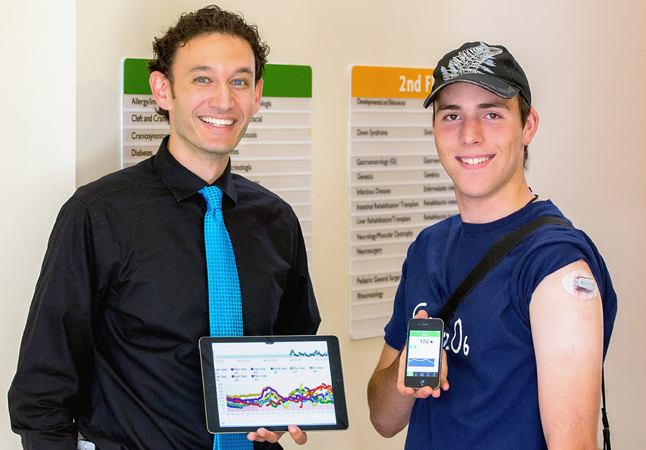At Stanford Medicine Children’s Health, an Apple HealthKit Pilot for Type 1 Diabetes Shows Promise

For Release: November 13, 2015
Lori Atkins’s 16-year-old son, Blake, has type 1 diabetes and she used to track his blood-sugar readings by hand. It was time intensive and sometimes scary, like the night he had a cold and “his numbers were going crazy.”
Lori paged Blake’s doctor and sat at a computer where she painstakingly emailed him the preceding 12 hours of her son’s glucose measurements to ensure the physician had all the vital data.
Now, however, those numbers are right at the doctor’s fingertips.
Rajiv Kumar, MD, pediatric endocrinologist at Stanford Medicine Children’s Health and Lucile Packard Children’s Hospital Stanford, has a novel way to access Blake’s blood sugar readings quickly and provide analysis without mom’s keyboard or a clinic appointment. And it’s all because of new healthcare technology by Apple.
Yes, the same Apple that brought the world the iPod, iPad and the Apple Watch.
In September 2014, the company released Apple HealthKit, an innovative software platform that can securely share patient-generated data with third-party applications. Kumar has been piloting HealthKit with 10 juvenile diabetes patients, including Blake, to look at how well the software works for tracking blood sugar levels.
One year later, Kumar has been so pleased with the pilot results that he is now offering the program to all of his patients who use a continuous glucose monitor and have an Apple mobile device with HealthKit.
“We’re very excited about this experience,” he said. “Our endocrinologists are now able to easily assess large volumes of blood sugar data between clinic visits—and immediately identify trends that could benefit from insulin dosing regimen changes. We securely review these assessments with the patients and their parents through our electronic medical record called MyChart. This has resulted in very insightful and timely feedback, particularly from our adolescent patients, into specific trends that guide our analysis.
“There is also an added benefit,” Kumar added. “We no longer need to download the data during clinic visits, and this allows us to spend more time with our patients and their parents.”
How does it work? Patients like Blake wear a Dexcom continuous glucose monitor (CGM) system that sends 288 blood sugar readings a day to an Apple mobile device through Bluetooth, and that data is transmitted via HealthKit into the patient’s MyChart record at Stanford Children’s Health. MyChart is powered by Epic, a leading electronic medical record provider.
Blake was diagnosed with type 1 diabetes four years ago, and he says that using a continuous glucose monitor linked to his iPhone and HealthKit has been a game changer, with updated information on estimated blood sugar readings every five minutes.
In the past, he and his mother tried to be diligent about communicating his glucose measurements and assessing his insulin dose needs—a necessity for treating the disease. But this wasn’t easy for Blake, who has school, homework, soccer practice and myriad other activities to keep him busy. That left most of the onus on Lori Atkins and what can best be described as a soon-to-be-old-school approach.
Now his mother is able to view her son’s CGM readings in real-time, and if she or Blake have questions or concerns about trends, they can ask Kumar to check Blake’s MyChart and provide feedback. No waiting until that next appointment.
“I love it,” said Lori Atkins. “HealthKit has really given us quicker response time and an open line of communication with Dr. Kumar. It’s been incredibly helpful.”
And for Blake, no additional effort is required.
“It’s not a hassle at all,” he said, adding that other than changing out the filament sensor once a week, he doesn’t have to track anything because the software does it for him. “It’s taken the pressure off.”
Having easy and timely access to Blake’s cumulative data helps Kumar see the big picture.
“By being able to look at a block of time, I’m able to detect patterns and pinpoint trends,” Kumar said. “I’m also learning more than I would from a routine three-month patient visit. It’s just a much more streamlined system. My favorite part has been the amount of input I’m receiving from adolescents to help clarify the blood glucose trends I’m seeing in their chart.”
“The success for patients like Blake,” added Kumar, “means that there could be many more ways this technology can deliver improved and timelier patient care.”
Discover more about Endocrinology.
About Stanford Medicine Children's Health
Stanford Medicine Children’s Health, with Lucile Packard Children’s Hospital Stanford at its center, is the Bay Area’s largest health care system exclusively dedicated to children and expectant mothers. Our network of care includes more than 65 locations across Northern California and more than 85 locations in the U.S. Western region. Along with Stanford Health Care and the Stanford School of Medicine, we are part of Stanford Medicine, an ecosystem harnessing the potential of biomedicine through collaborative research, education, and clinical care to improve health outcomes around the world. We are a nonprofit organization committed to supporting the community through meaningful outreach programs and services and providing necessary medical care to families, regardless of their ability to pay. Discover more at stanfordchildrens.org.
Connect with us:
Download our App: